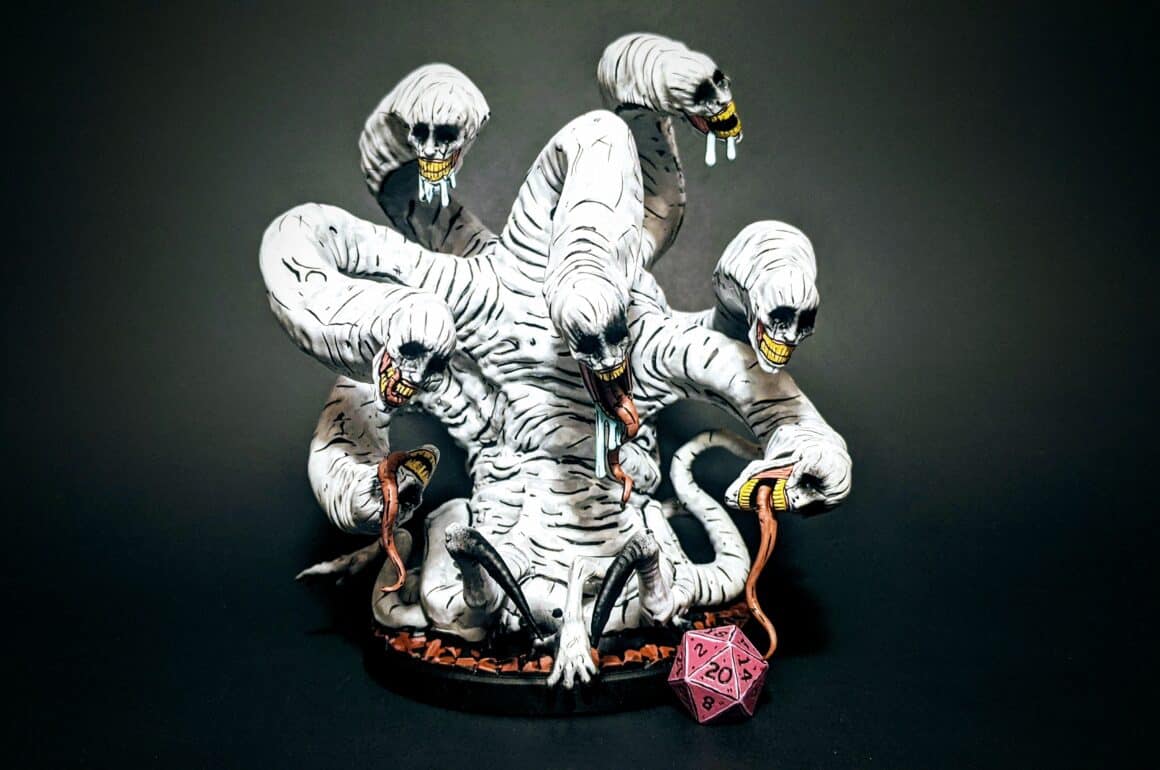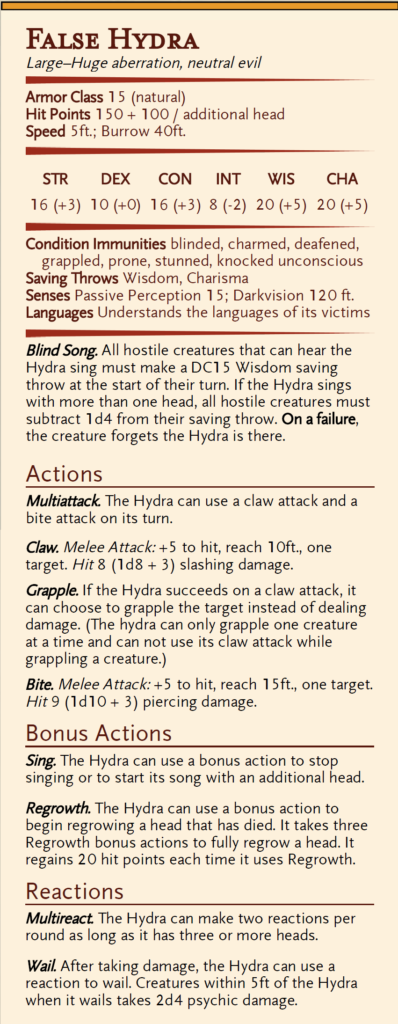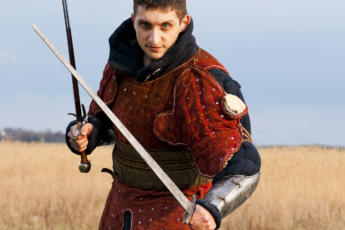
The False Hydra is something you hear players’ tall, harrowing stories about, and DMs speak on with reverence. As a result, False Hydra is one of the most popular homebrews to come out in recent memory.
Warning!
If you are a player that may fight a False Hydra, DO NOT READ THIS ARTICLE. It will spoil all of the fun of the monster.
What is the False Hydra?
Where did it come from?
Who made it?
How do we use it to improve our D&D experience?
Which version should you use?
In this article, I will answer all these questions and more. So, pull up a chair and get ready to learn about one of the most legendary homebrews that bring both DMs and players to a new level in Dungeons & Dragons 5th edition.
What is the False Hydra?
A False Hydra is a terrifying monster with sickly white, pale skin and multiple heads on long necks. Instead of dragon heads like an original hydra, it has human heads with blackened eyes and large white teeth.
Sounds horrible, right? The worst thing is even if you see this creature, as soon as it begins to sing its Blind Song/Mindsong (depending on which stat block you use), there’s a good chance you will forget it was ever there.

Where did the False Hydra come from?
The original idea of the False Hydra came from the Goblin Punch blog. Its creator, Arnold Kemp, wrote the original blog on September 4th, 2014. The blog itself was mostly a concept, no stat block was provided, however, it was a fantastic idea and sparked the imagination of the D&D community.
Arnold is still writing great content and has his own Patreon page. Check it out here: Goblin Punch Patreon
False Hydra stat blocks.
Since its conception, several stat blocks have come out for the False Hydra. One is from the Dungeon Masters Guild by Rachel Morgan, and the other is on DND Beyond, posted by Oats1321.
The first stat block we will look at is by Rachel Morgan on the Dungeon Masters Guild website. Rachel did a fantastic job, and the stat block is well-designed. There are only a couple of things missing; the challenge rating and the rules on killing the False Hydra heads.
Fales Hydra Stat Block by Rachel Morgan

Looking at the stat block, I would judge the challenge rating to be somewhere between 7 or 8. It could be considered higher because of the hit points, however, this False Hydra’s physical attacks aren’t terribly high. They’re not low, but they’re not high as far as damage output.
The other thing missing is how the Hydra’s heads die. The regular hydra in the monster manual states, “Whenever the hydra takes 25 or more damage in a single turn, one of its heads dies. If all its heads die, the hydra dies.” I would go a little higher for the False Hydra, think 50 to 75 damage per round.
Higher Level Stat Block
This second stat block was posted by Oats1321 on D&D Beyond. With over 47,000 views, this is by far the most popular stat block and the most powerful version I’ve seen.
With a challenge rating of 14, legendary actions, resistance to innate spellcasting, wonderful multiple head rules, and a myriad of different kinds of attacks, this is by far my favorite of the two stat blocks.
Fales Hydra Stat Block by Oats1321

The one thing that both stat blocks are missing is the dying head mechanics. The regular hydra found in the monster manual reads.
“Whenever the hydra takes 25 or more damage in a single turn, one of its heads dies. If all its heads die, the hydra dies.”
The regular hydra has five heads. Since the False Hydra will probably have fewer heads, I would suggest changing 25 damage to 50 or 100.
If you really want to harness the true terrifying monster that the False Hydra is, this is the one I would choose.

Using a False Hydra
The False Hydra is one of those wonderful monsters that are great for both role-playing and combat. Anytime you can combine these two aspects, it really adds to the experience for your players.
In my opinion, the best way to run a False Hydra would be in a small town, one that has been the Hydra’s hunting ground for quite some time. This way, your players can interact with the populace that has been unknowingly suffering for a long time.
Maybe your party meets a set of young twin boys that tried to play with the adventurers only to see just one of them the next day. When you question him where his twin is, he simply replies he never had a twin, but he always wanted one to play with.
Or, on your way into town for the first time, you passed the blacksmith, hard at work. He shouts a greeting and offers your adventuring party to look at his fine swords and armor. However, the next morning when they wake, the forge is cold and nobody is there. When they ask around, people say they have never had a blacksmith, though his shop is full and no one knows where the goods came from.
Ultimately, you want the mystery to hook your players. Then, allow the loss of memories, maybe even the loss of their own memories, to increase the paranoia of your players.
The False Hydra’s Song
The False Hydra’s song is by far the most unique aspect of this creature. Both stat blocks we’ve looked at have a description of the False Hydra’s Song, but the one written by Oats1321 is superior mainly because it is more spelled out.
- Oats1321 – False Hydras Song
‘’ Mindsong.
The false hydra sings a harrowing melody which is heard by anyone within 5 miles of the head that sings. Only one head needs to sing and having additional heads join the song provide no benefits. Creatures hearing the song gain gaps in their memory that they have no recollection of. If a person enters a room with a false hydra, the song may cause the person to forget the hydra was there. This is commonly used to cause people who are close to victims of the hydra to forget that person existed’’.
‘’This song does not alter reality, only perception. A woman who lost her husband may find it confusing to find men’s clothes in her house as she recalls no husband. This effect does not work on people who are deaf, or are focused on the item the gap is intended to replace. For example, the women above may witness the hydra eating a man, and recall all of it during the event, but forget the second she looks away.’’
As people are victims to the mindsong, they risk gaining split minds. If a victim gains split mind, the left half of the mind separates from the right. The victim does not notice this, however the left half cannot hear, thus is immune to the mindsong (but it can see). It may try to notify the victim of the hydra, but it only controls half the body. It does not control speech. This may appear as the left hand inserting text into a note the victim is writing, or scratch letters into their chest as they sleep. Since the right brain is still impacted by the mindsong, they may never notice the letter, however the scars on their chest are harder to blank out of their mind.
How to use it
You’ll notice that this doesn’t have a saving DC. Personally, I think this ability is mainly used for the narrative aspects, not in battle. I would use this song to wipe my party’s memory a few times to confuse them, but eventually, they need to discover the cause is a False Hydra, therefore you can’t do it too many times.
For example, you could have them travel into a tunnel to look for some missing people. They round the corner after they hear a noise that sounds like the crunching of bones. As they draw closer, the crunching stops and they begin to hear a haunting melody. Then you tell them that they find themselves standing in a tunnel that they have never seen before. They don’t know how they got in there or what they’re doing there. Then sit back and enjoy the mayhem.
Now, a word of caution. I would not suggest using this song more than once or twice on your players. Since it does not have a save DC, your players may get a little frustrated at the situation. Ultimately, we want them to discover the reason why they are forgetting so that they can fight the false hydra. So, use this skill sparingly.
Defeating the False Hydra
After you have tortured your players with the False Hydra’s song a few times, it’s now time for them to find and possibly defeat the False Hydra. But how do they do this? There are a few different ways your players can go about it.
- Plugging their ears
- Spells such as True Seeing or Silence
- Items such as A Crystal Ball of True Seeing
- Mirrors
Plugging Their Ears
This is probably the first thing your players will think of and the easiest to suggest. If your players do not think of it on their own, you could always introduce a half-eaten dead adventurer missing an ear with cotton stuck in the other one.
If they can’t hear the False Hydra song, then they will not lose their memories, though they will suffer the deaf condition if their ears are plugged.
Spells
A spell like True Sight will allow the caster the ability to see through the hydra’s song. Silence could also be used, allowing no song to be heard within its radius.
Mirrors
It’s up to you as a DM if you would like to allow mirrors. The idea is that if they are not looking directly at the hydra, they should be able to see it, since the hydra song does not alter reality. It is up to translation. However, if this is the only idea your players come up with, give it to them.
After your players are no longer affected by the Hydra song, all you must do is run the battle. With the False Hydra’s crazy amount of hit points, strong basic attacks, Engulf, Sonic Blast, innate spellcasting (including Dominate Monster), and the wonderful mechanic of eating somebody to grow an extra head, it should be one hell of a fight.

FAQs About the False Hydra
Why is it called a false hydra?
The original idea of the False Hydra came from the Goblin Punch blog. Its creator, Arnold Kemp, wrote the original blog on September 4th, 2014. Unfortunately, Arnold does not state in the blog post why it is named False Hydra. It was most likely named this because, like the normal hydra found in the monster manual, it possesses multiple heads.
How many heads does a False Hydra have?
The number of heads is up to the DM. However, you should always consider the fact that the challenge rating will increase with more heads. I would suggest using a mechanic that requires your party to deal a certain amount of damage to kill one head, let’s say 50 hit points. If you are using a False Hydra with two heads then they would have 100 hit points. Four heads, 200 points, and so on. This would be an easy way to decide how many heads your False Hydra has and you could always scale it in battle if your hydra is too strong or too weak.
How do you kill a False Hydra?
Both popular stat blocks that exist for the False Hydra do not list a special way to kill it. However, I would use the mechanic for the regular hydra in the monster manual with a little adjustment. The monster manuals hydra states, “Whenever the hydra takes 25 or more damage in a single turn, one of its heads dies. If all its heads die, the hydra dies.” I would simply increase the amount of damage required to either 50 or 100 points of damage. Once all of the false hydra heads are dead, it is dead.





Leave a Comment